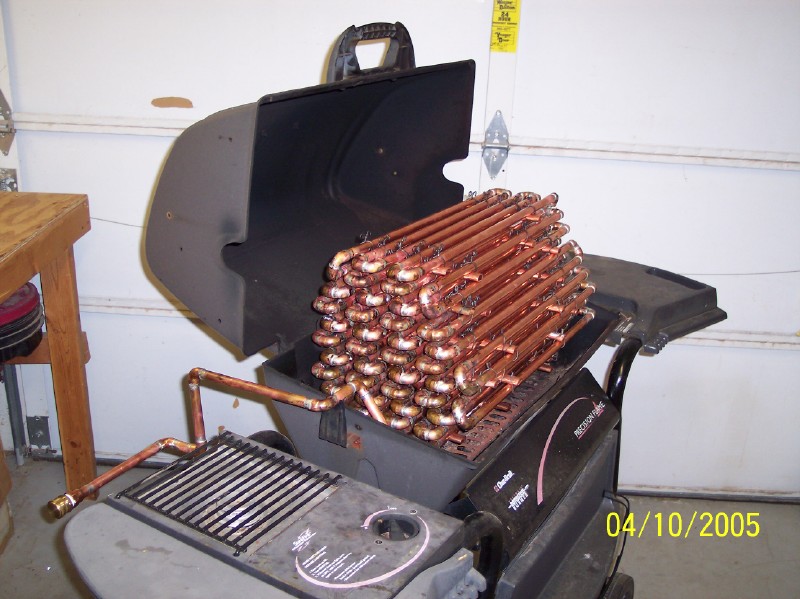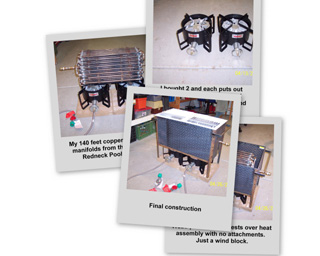First |Previous Picture |Next Picture |Last

![]() Hall of Fame - Stories and photos about other Makers that have built Redneck Pool Heaters.
Hall of Fame - Stories and photos about other Makers that have built Redneck Pool Heaters.

INTRO:
Even thou modifying your gas grill into a pool heater is a
redneck mod I feel justified for several reasons.
1) It worked!
2) I’m actually educated (not so redneck, I know)
a. This mod took a lot of drafting, calculations and prototyping to construct the heat exchange coils which realized 84% efficiency.
b. Some of these design skills I learned from my college years at North Dakota State University where I received my Bachelor of Science in Engineering Physics (1993).
3) I quite enjoy swimming in my pool in the winter months.
a. I only heat my pool when my family feels like swimming on special weekends like birthdays and holidays.
b. It only costs me about $28 in propane.
c. This cost is a long ways from the costs of a real pool heater not to mention the installation of a gas line to the pool heater which can cost thousands alone.
4) Finally, my father was in the heating and air-conditioning business most of his life but sadly to say he passed away in 2004.
a. About a year before his death I presented my idea to mod my gas grill into a pool heater to my father. I explained my general plan and within 10 seconds he guessed at the pools size, calculated the BTU’s needed and knowing the BTU’s in a tank of propane by heart he told me it would take 4 to 6 tanks of propane and 3 to 4 days.
b. After his death I decided I needed to find out just how close his guess was. At first I was surprised that my calculations showed he was right in the middle of the ballpark with his numbers but the proof is in the pudding so I had to build at least a prototype. Well, when the prototype functioned magnificently for its size I kicked into R&D high gear.
c. My 13 year old Daughter Veronica and I spent every night and two full weekends designing and constructing the full-size coils. Forty hours of labor and $250 in parts and supplies later we started our pool heater. Below you can read about our final numbers which show my father really know his stuff and to imaging he got that close just guessing at the pool size and it only took him 10 seconds, WOW.
This mod took about 40 hours of labor and $250 in 1/2 inch copper pipe, elbows and solder. Tips: ----- You will need a pool cover when heating for it to work best. Make sure water is always flowing before you turn on the flames because the sweat solder joints will melt if there is no water in the pipes. When in use the pipes will sweat a lot of water condensation that looks like a leak. Design upgrade -------------- Keep the coils at least 6 inches from the flame to help combustion. If you don't then you will have to prop the lid open about 3 inches to get extra air to the flames or put a vent in the top of the grill lid to help the draft like I did. Keep an eye on it at first to make sure the flame does not go out. You don't want to loose all your propane or start a big fire. ,Todd Harrison
Efficiency calculations by Benjamin Kokes Pool Capacity = 8000 Gallons Initial pool Temp = 68 F Final pool temp = 89.4 F BTU's in propane = 95,475 BTU Weight of 1 gal of water = 8.35 pounds BTU's to heat 1 pound of water 1 degree F = 1 BTU BTU's required to heat 66,800 pounds of water: 1,402,800 BTU Gallons of propane required to heat 66,800 pounds of water: 14.69 gal Gallons of propane gill heater used to heat 66,800 pounds of water: 17.5 gal BTU's you used to heat 66,800 pounds of water: 1,670,812.5 BTU Dividing the BTU's required by the BTU's used gives an efficiency of about 83.4%. This figure is a bit misleading because the warm water flowing into the pool was cooled off a bit as you were raising the total temperature. So it should be read as the efficiency is BETTER than 83.4%. To calculate the number of tanks of propane needed at 80% efficient: ---------------------------------------------------------------------- Lets start with the gallons of water in your pool. Times that by 8.35 to get pounds of water in pool. Times that by degrees F you want to raise your pool temp to get the BTUs needed. Divide that by 95,475 to get the gallons of propane needed. Divide that by 4.1 to get the number of 20 pound propane tanks needed. This is a calculated number based on 100% efficiency so lets adjust this down to 80% efficiently which is a about as good as you can do with a gas grill. To do this simply times your number of tanks needed by 1.2 which is a 20% increase in tanks needed to account for the lost 20% in your efficiency.